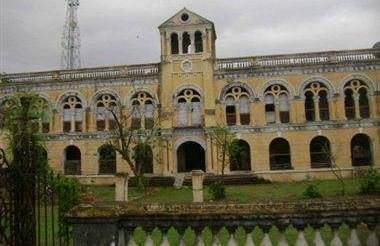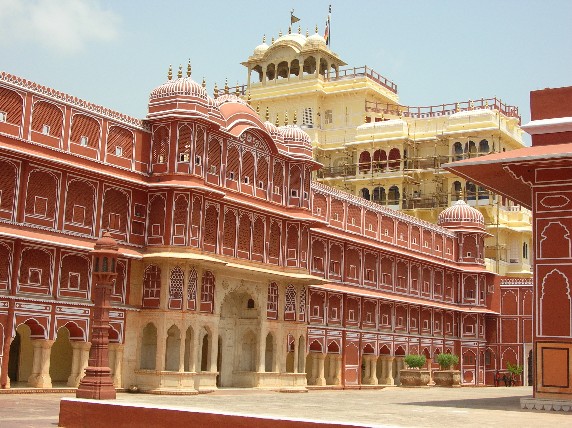|
Kahlur Fort
Kahlur Fort is situated in erstwhile princely state of Kahlur (also known as Bilaspur) in Himachal Pradesh. The state was founded in/ around 697 by Bir Chand. HANDEL RAJPUT RULERSlater Kahal Chand had built a fort, which was named after him, and was called Kot Kahlur. Another ruler of the state, Dip Chand founded Bilaspur, and made the place as his capital. History After the death of Harshaverdhna of Kanauj towards the end of seventh century A.D., Harihar Chand of Chanderi after crowned his eldest son Govind Chand set-forth on his journey northwards to follow the footsteps of his royal ancestors, Raja El Dev and Rani Bimla Devi, who were reputed to have visited Bilaspur (then Vyaspur) along with his four sons and a handful of true followers. On the way at Nadaun (headquarter of Kangra), the Katoch ruler invited the Chandel prince to encamp there for few days. A tent-pegging contest was arranged by the Kangra chief and the fourth son of Harihar Chand was killed in the contest ... [...More Info...] [...Related Items...] OR: [Wikipedia] [Google] [Baidu] |
Princely State
A princely state (also called native state or Indian state) was a nominally sovereign entity of the British Raj, British Indian Empire that was not directly governed by the British, but rather by an Indian ruler under a form of indirect rule, subject to a subsidiary alliance and the suzerainty or paramountcy of the the Crown, British crown. There were officially 565 princely states when India and Pakistan became independent in 1947, but the great majority had contracted with the viceroy to provide public services and tax collection. Only 21 had actual state governments, and only four were large (Hyderabad State, Mysore State, Kashmir and Jammu (princely state), Jammu and Kashmir State, and Baroda State). They Instrument of accession, acceded to one of the two new independent nations between 1947 and 1949. All the princes were eventually pensioned off. At the time of the British withdrawal, 565 princely states were officially recognised in the Indian subcontinent, apart from t ... [...More Info...] [...Related Items...] OR: [Wikipedia] [Google] [Baidu] |
Kahlur
Bilaspur State or Kahlur State, sometimes Kahloor Riyasat, was a kingdom (697-1849) and later princely state (1849-1948) in the Punjab Province ruled by a separate branch of Chandravanshi Chandel dynasty.Raja Bir Chand 697-730 was the founder of the state but it was named as Kahlur only after the Construction of Kahlur Fort by Raja Kahal Chand around 890-930CE and Raja Anand Chand the 44th Raja was the last ruler. The state was Earlier known as Kahlur Riyasat and was later renamed Bilaspur. It covered an area of , on the name of River Bias (from Biaspur later became Bilaspur) and had a population of 100,994 according to the 1931 Census of India. The last ruler of Bilaspur State acceded to the Indian Union on 12 October 1948. Bilaspur State remained Bilaspur Province in independent India until 1950 when the province was briefly renamed "Bilaspur State" before it was merged with Himachal Pradesh state as a district in 1954. In the pre-partitioned Punjab, the Raja of Ka ... [...More Info...] [...Related Items...] OR: [Wikipedia] [Google] [Baidu] |
Himachal Pradesh
Himachal Pradesh (; ; "Snow-laden Mountain Province") is a state in the northern part of India. Situated in the Western Himalayas, it is one of the thirteen mountain states and is characterized by an extreme landscape featuring several peaks and extensive river systems. Himachal Pradesh is the northernmost state of India and shares borders with the union territories of Jammu and Kashmir and Ladakh to the north, and the states of Punjab to the west, Haryana to the southwest, Uttarakhand to the southeast and a very narrow border with Uttar Pradesh to the south. The state also shares an international border to the east with the Tibet Autonomous Region in China. Himachal Pradesh is also known as , meaning 'Land of Gods' and which means 'Land of the Brave'. The predominantly mountainous region comprising the present-day Himachal Pradesh has been inhabited since pre-historic times, having witnessed multiple waves of human migrations from other areas. Through its history, the ... [...More Info...] [...Related Items...] OR: [Wikipedia] [Google] [Baidu] |
Bilaspur, Himachal Pradesh
Bilaspur is a town and a municipal council in Bilaspur district in the Indian state of Himachal Pradesh. History Bilaspur was the capital of a state of the same name founded in the 7th century, also known as Kahlur. The ruling dynasty were Chandel Rajputs, who claimed descent from the rulers of Chanderi in present-day Madhya Pradesh. The town of Bilaspur was founded in 1663. The state later became a princely state of British India, and was under the authority of the British province of Punjab. On 13 May 1665, Guru Tegh Bahadur went to Bilaspur to attend the mourning and funeral ceremonies for Raja Dip Chand of Bilaspur. Rani Champa of Bilaspur made an offer to the Guru of a piece of land in her state, which the Guru accepted at the cost of 500 rupees. The land consisted of the villages of Lodhipur, Mianpur, and Sahota. Guru Tegh Bahadur broke ground on a new settlement on 19 June 1665, which he named Nanaki after his mother. In 1932, the state became part of the newly cre ... [...More Info...] [...Related Items...] OR: [Wikipedia] [Google] [Baidu] |
Chandel (Rajput Clan)
Chandel or Chandela is a Rajput clan from India. Families belonging to this clan ruled several kingdoms in north India and held various feudal estates. The most notable of these were the Chandelas of Jejakabhukti, who ruled the Bundelkhand region. History During 10th to 13th century CE, the Chandelas of Jejakabhukti ruled the Bundelkhand region in present-day Madhya Pradesh and Uttar Pradesh. Chandel claim Chandravansh lineage, Historians Such as CV Vaidya and GS Ojha consider these Chandela Rajput to be of Pure Lunar(Chandravansh) lineage. The British indologist V. A. Smith theorised that the Chandelas were of either Bhar or Gond origin, this theory was not supported by some scholars including C V Vaidya because this Bhar and Gond Origin theory was based on Marriage of Durgavati to a king of Gond kingdom Dalpat shah who was not a Gond but a Kachhhwaha Rajput adopted by King Amandas Gond according to Akbarnama. After the decline of Kalchuri Rajput remaining Kalchuri Raj ... [...More Info...] [...Related Items...] OR: [Wikipedia] [Google] [Baidu] |
Rajput Architecture
Rajput architecture is a architectural style notable for the forts and palaces of the many Rajput rulers, which are popular tourist attractions, many of the Rajput forts are UNESCO World Heritage Site. Rajput architecture represents different types of buildings, which may broadly be classed either as religious These include temples, forts, stepwells, gardens, and palaces. The forts were specially built for defense and military purposes. The Mughal architecture greatly influenced indigenous Rajput styles of art and architecture. Rajput architecture continued well into the 20th and 21st centuries, as the rulers of the princely states of British India commissioned vast palaces and other buildings, such as the Albert Hall Museum, Lalgarh Palace, and Umaid Bhawan Palace. These usually incorporated European styles as well, a practice which eventually led to the Indo-Saracenic style.Michell, George (1990), ''The Penguin Guide to the Monuments of India, Volume 1: Buddhist, Jai ... [...More Info...] [...Related Items...] OR: [Wikipedia] [Google] [Baidu] |
Forts In Himachal Pradesh
A fortification is a military construction or building designed for the defense of territories in warfare, and is also used to establish rule in a region during peacetime. The term is derived from Latin ''fortis'' ("strong") and ''facere'' ("to make"). From very early history to modern times, defensive walls have often been necessary for cities to survive in an ever-changing world of invasion and conquest. Some settlements in the Indus Valley civilization were the first small cities to be fortified. In ancient Greece, large stone walls had been built in Mycenaean Greece, such as the ancient site of Mycenae (famous for the huge stone blocks of its 'cyclopean' walls). A Greek '' phrourion'' was a fortified collection of buildings used as a military garrison, and is the equivalent of the Roman castellum or English fortress. These constructions mainly served the purpose of a watch tower, to guard certain roads, passes, and borders. Though smaller than a real fortress, they ... [...More Info...] [...Related Items...] OR: [Wikipedia] [Google] [Baidu] |




